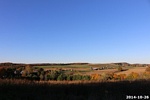
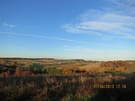
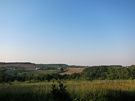
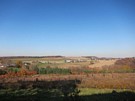
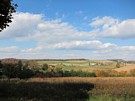
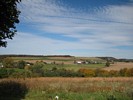
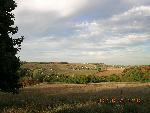
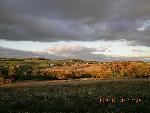
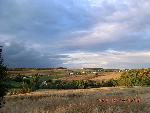
Last Updated: 19-AUG-2018
Click on image to make it larger
Views
From the house looking North (new Cell tower arrived in the summer of 2009)
2014, 2013, 2012, 2011, 2010, 2009, 2007, 2006, 2004
From the house looking East
2014, 2013, 2012, 2011, 2010, 2009, 2007, 2006, 2004
The west side of the house from atop the garage
2011 Can't go up on the garage roof anymore due to new metal garage roof. Took photo high on the one side.
2010 The siding is 100% done. The addition is all done !
2009 you can see the back porches are gone !
2012, 2011, 2010, 2009, 2008, 2007 & 2002
Looking down the driveway
2014, 2013, 2011, 2009, 2007
In 2014 we removed the Bradford Pears. The previous owners planted these as they had no understanding of the problems that these trees present.
Bradford pear is a specific cultivar of the ornamental Callery pear. It usually grows 25-30 feet tall, with a canopy perhaps 20-25 feet wide, noted for its lovely, uniformly rounded form. That consistently rounded shape lends itself to symmetrical landscape plantings, and many homeowners will plant Bradfords to line their driveways. The tree blooms dependably, displays wonderful fall color, and, best of all, has virtually no insect or disease problems. Unfortunately, that's where the good news about Bradford pears comes to an end.
Structural weakness is not the only drawback associated with Bradford pears, though. Originally bred to be sterile, this ornamental pear tree was never intended to produce fruit.
The offspring of those well-mannered ornamental pears are, to put it nicely, aggressive thugs. They spread rapidly with the help of birds dropping their seeds, and the resulting plants are thorny invaders, choking out native wildlife habitat wherever the seedlings take hold. The problem is severe enough that many localities have banned the Bradford pear altogether in certain settings.
If all this weren't discouraging enough, Bradford pears just don't live a long time, as trees go. Starting around the age of 20, the trees simply begin to decline, with few of them living past the age of 30.
All gone in a easy afternoon.
Looking up the driveway from near the bottom
2012, 2004
Bad ice problems at the bottom of the driveway winter 2014-2015. This year I will try to keep this from occurring
FEB 2004 Looking up towards the house on a very cold winter day
DEC 2009, 2007 & JAN 2003 Looking towards the garage and barn from the house
CSX Hanover Subdivision
AUG 2012 North bound empty rock runner on the CSX Hanover Sub (This view is from our property)
JUL 2010 North bound empty rock runner on the CSX Hanover Sub
NOV 2008 North bound empty rock runner on the CSX Hanover Sub
JAN 2007 North bound empty rock runner on the CSX Hanover Sub
MAY 2005 Looking at a CSX Hanover Sub mixed freight heading north.